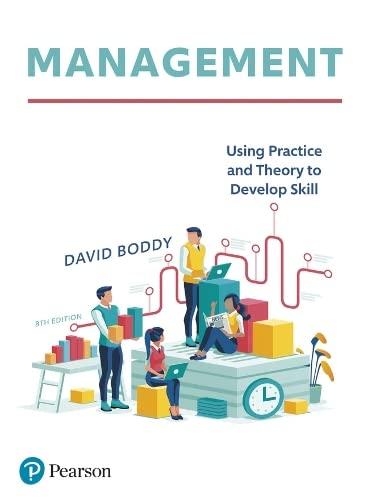Question
Classifying Theories of Organizational Change 1.How useful is the image of managing change framework for locating and making sense of change management theories? 2.Identify and
Classifying Theories of Organizational Change
1.How useful is the image of managing change framework for locating and making sense of change management theories?
2.Identify and explain a set of guiding principles for the strategic management of change and innovation.
3.Why do businesses in highly competitive markets often feel under pressure to mimic the behaviour of 'successful' competitors?
4.Discuss what you understand by the term 'change paradox'.
Human Dimensions: Readiness, Time Perspectives, Communication, Power, Politics and Resistance
1.Explain the concept of readiness for change and evaluate its strengths and limitations.
2.How useful is the notion of individual time perspective for understanding the way perspectives on time can influence actions and reactions to change?
3.What is the communication process and compare and contrast programmatic and participatory approaches.
4.Provide an example of each of French and Raven's five types of power.
5.What are the main reasons why people resist change?
6.Is resistance an inevitable obstacle of change that needs to be overcome, or can resistance be a useful source of knowledge and understanding that can support positive change?
1.'The Organizational Development approach to change continues to dominate the literature because the value of this approach has been proven in practice.' Discuss this statement.
2.Debate the pros and cons of Lewin's three-step model of unfreezing, moving or changing, and refreezing.
3.Evaluate the claim by Dunphy and Stace that there are occasions where more coercive and autocratic strategies for managing change are required.
4.Explain why the Kotter's eight-step model has proven to be so popular, and assess the strengths and weaknesses of his proposed approach.
5.Compare and contrast Lewin's three-step and Kotter's eight-step model, and discuss the claim by Hendry (1996: 624) that if you: 'Scratch any account of creating and managing change and the idea that change is a three-stage process that necessarily begins with a process of unfreezing will not be far below the surface.'
6.Provide a critical assessment of Kotter's idea of a dual operating system for making change happen in an accelerating world.
1.In a foreword to Bushe and Marshak's (2015) Dialogic Organization Development, Edgar Schein (2015) claims that: 'Dialogic Organizational Development (OD) could not have arrived at a better time. The assumptions underlying it and some of the goals for social change and improvement that it articulates not only build on an important historical legacy but reinforce those aspects of OD that will be most need in the future.' Discuss and assess this claim.
2.Identify and discuss the key underlying principles of the 'new' dialogical organizational development approach to organizational change.
3.Construct a table that compares and contrasts the similarities and differences between diagnostic and dialogical OD.
4.Explain what you understand by the term 'the art and practice of the learning organization' and outline some of the main strengths and weaknesses of this approach.
5.Outline the key components of the change kaleidoscope framework and evaluate the practical value of the approach for managing organizational change.
6.What are the advantages and disadvantages of Jabri's model that combines Lewin's three stages of change with a more process-oriented dialogical approach?
7.Provide a critical assessment of appreciative inquiry, setting out the advantages and disadvantages of the approach for: (a) understanding processes of change; (b) planning processes of change; and (c) enabling improvisational and emergent change to occur.
8.evaluate which of the frames or models discussed in this chapter would best align and explain the reasons why.
9.Reflect on the notions of objective and subjective, then consider whether there is a clear division between the two or whether the boundaries blur.
Step by Step Solution
There are 3 Steps involved in it
Step: 1

Get Instant Access to Expert-Tailored Solutions
See step-by-step solutions with expert insights and AI powered tools for academic success
Step: 2

Step: 3

Ace Your Homework with AI
Get the answers you need in no time with our AI-driven, step-by-step assistance
Get Started


